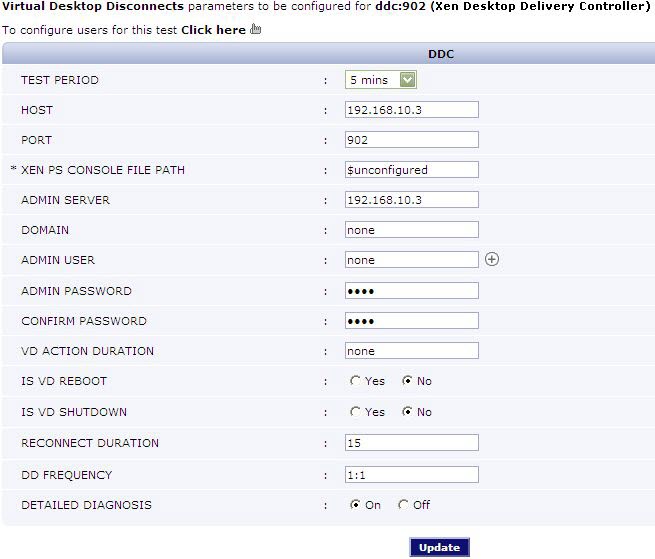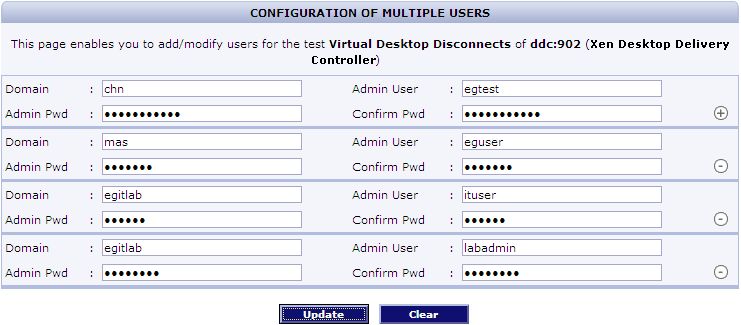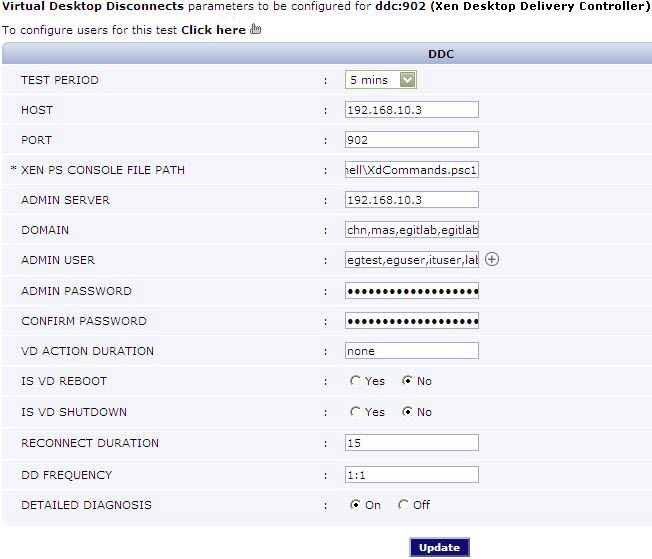Virtual Desktop Disconnects in Farm Test
A user session is terminated when a user logs off from the desktop or when the session is abruptly interrupted. When a user logs off, all the applications started by the user are terminated. However, when a user disconnects, the applications started by the user will keep running on the desktop consuming resources. Hence, the number of disconnected sessions on a desktop should be kept to a minimum.
In some environments, desktop administrators may also wish to automatically restart/shutdown those virtual desktops with sessions that are in a disconnected state for a long period of time.
This test reports the total number of disconnected sessions to the desktops managed by a Xen DDC farm, and also automatically restarts/shuts down the virtual desktop, if the disconnected session duration to that desktop exceeds a configured value.
Target of the test : A Citrix Delivery Controller v3/4
Agent deploying the test : An internal agent
Outputs of the test : One set of results for the Xen DDC farm that is being monitored.
| Parameter | Description |
|---|---|
|
Test Period |
How often should the test be executed. |
|
Host |
The IP address of the host for which this test is to be configured. |
|
Port |
Refers to the port at which the specified host listens to. |
|
Admin User and Admin Password |
If you want the test to automatically reboot/shut down virtual desktops if the duration of disconnected sessions to the desktops exceeds a configured value, then you first need to grant the test the privilege to access the desktops. For this purpose, in the Admin User and Admin Password text boxes, provide the credentials of a user with administrative privileges to the hosting provider (VC or XenServer) of the desktops. If the test needs to monitor session disconnects across multiple hosting providers, then multiple admin users and admin passwords need to be provided – one for every hosting provider. To help administrators provide these user details quickly and easily, the eG administrative interface embeds a special configuration page. To access this page, simply click on the Click here hyperlink that appears just above the parameters of this test in the test configuration page. To know how to use the special page, refer to Configuring users for disconnected sessions monitoring of this document. By default, these parameters are set to none; this indicates that the test is not authorized to reboot/shut down desktops by default. |
|
VD Action Duration |
The test will automatically reboot/shut down virtual desktops, if the disconnected session duration (in minutes) specified here is violated. |
|
Is VD Reboot |
Set this flag to True if the test needs to restart the desktop if the configured VD Action Duration is exceeded. By default, this flag is set to False. |
|
Is VD Shut Down |
Set this flag to True if the test needs to shut down the desktop if the configured VD Action Duration is exceeded. By default, this flag is set to False. Note: Note that only one of the two flags – Is VD Reboot and Is VD Shut Down – can be set to True at any given point in time. If both are set to False, then the test will neither reboot nor shut down any virtual desktops. If one flag is set to True, but the Admin User and Admin password text boxes are configured with none, then again the test will neither reboot nor shut down any virtual desktops. |
|
Reconnect Duration |
This parameter is used by the test while computing the value for the Quick reconnects by users measure. This measure counts all the users who reconnected to the virtual desktops within the short period of time (in minutes) specified against Reconnect Duration. |
|
DD Frequency |
Refers to the frequency with which detailed diagnosis measures are to be generated for this test. The default is 1:1. This indicates that, by default, detailed measures will be generated every time this test runs, and also every time the test detects a problem. You can modify this frequency, if you so desire. Also, if you intend to disable the detailed diagnosis capability for this test, you can do so by specifying none against DD frequency. |
|
Detailed Diagnosis |
To make diagnosis more efficient and accurate, the eG Enterprise embeds an optional detailed diagnostic capability. With this capability, the eG agents can be configured to run detailed, more elaborate tests as and when specific problems are detected. To enable the detailed diagnosis capability of this test for a particular server, choose the On option. To disable the capability, click on the Off option. The option to selectively enable/disable the detailed diagnosis capability will be available only if the following conditions are fulfilled:
|
| Measurement | Description | Measurement Unit | Interpretation |
|---|---|---|---|
|
Total disconnected sessions |
Indicates the total number of sessions that are in the disconnected state. |
Number |
The detailed diagnosis for this measure provides the complete details of disconnected sessions on the virtual desktops managed by the Xen DDC farm. |
|
New disconnects |
Indicates the number of sessions that were disconnected in the last measurement period |
Number |
The detailed diagnosis for this measure can be used to track whether specific users are being disconnected often. |
|
Quick reconnects by users |
Indicates the number of users who reconnected soon after a disconnect. |
Number |
The detailed diagnosis of this measure, if enabled lists the users who have reconnected quickly. |
|
Successful restarts /shut downs |
Indicates the number of virtual desktops that were shut down/restarted successfully by this test. |
Number |
These measures will appear only if the following conditions are fulfilled:
|
|
Failed restarts / shut downs |
Indicates the number of virtual desktops that could not be restarted/ shut down by this test. |
Number |
Configuring users for disconnected sessions monitoring
In order to enable the eG agent to automatically reboot/shut down virtual desktops managed by multiple hosting providers (VC or XenServer), the Virtual Desktop Disconnects test must be configured with multiple domains, admin users, and admin passwords – one for every hosting provider. To enable you to provide these user details easily, the eG administrative interface provides a special page. To access this page, just click on the Click here hyperlink in the Virtual Desktop Disconnects test configuration page.

Figure 1 : Configuring the Virtual Desktop Disconnects test
Upon clicking, Figure 2 will appear, using which the VM user details can be configured.

Figure 2 : The VM user configuration page
To add a user specification, do the following:
- First, provide the name of the Domain to which the VMs belong (see Figure 2).
- The eG agent must be configured with user privileges that will allow the agent to automatically restart/shutdown the desktops managed by different hosting providers. If a valid Domain name has been specified, then a domain administrator account can be provided in the Admin User text box.
- The password of the specified Admin User should be mentioned in the Admin Pwd text box.
- Confirm the password by retyping it in the Confirm Pwd text box.
- To add more users, click on the
 button in Figure 2. This will allow you to add one more user specification.
button in Figure 2. This will allow you to add one more user specification. -
In some virtualized environments, the same Domain could be accessed using multiple Admin User names. For instance, to login to a Domain named egitlab, the eG agent can use the Admin User name labadmin or the Admin User name ituser. You can configure the eG agent with the credentials of both these users as shown by Figure 3.
The same ‘Domain’ mapped to different ‘Admin Users’

Figure 3 : Associating a single domain with different admin users
When this is done, then, while attempting to connect to the domain, the eG agent will begin by using the first Admin User name of the specification. In the case of Figure 3, this will be ituser. If, for some reason, the agent is unable to login using the first Admin User name, then it will try to login again, but this time using the second Admin User name of the specification - i.e., labadmin in our example (see Figure 3). If the first login attempt itself is successful, then the agent will ignore the second Admin User name.
- To clear all the user specifications, simply click the Clear button in Figure 3.
- To remove the details of a particular user alone, just click the
 button in Figure 3.
button in Figure 3. -
To save the specification, just click on the Update button in Figure 3. This will lead you back to the test configuration page, where you will find the multiple domain names, user names, and passwords listed against the respective fields (see Figure 3).

Figure 4 : The test configuration page displaying multiple domain names, user names, and passwords



